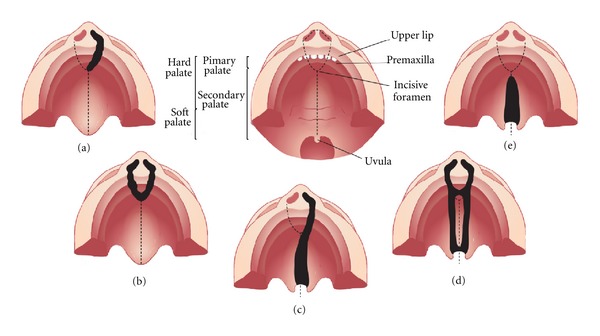Common Types of Palatal Clefts
The illustration below (see Brito et al., 2012) shows the most common types of cleft. The primary palate consists of structures anterior to the incisive foramen. These structures include the upper lip and premaxilla, which is the triangular-shaped bone that includes the alveolar ridge. The secondary palate consists of structures that are posterior to the incisive foramen. These structures include the hard palate, velum, soft palate, and uvula.

© Copyright/License - Open Access
Figure 1: Representation of the most common types of cleft affecting the palate. (a) Unilateral cleft lip with alveolar involvement; (b) bilateral cleft lip with alveolar involvement; (c) unilateral cleft lip associated with cleft palate; (d) bilateral cleft lip and palate; (e) cleft palate only (© Copyright Brito, Meira, Kobayashi, & Passos-Bueno, 2012).
Palatal clefts can be overt or submucous. An overt palatal cleft is a visible opening in the roof of the mouth that can be observed on intraoral inspection. In a submucous cleft palate (SMCP), the oral mucosa is intact, but the underlying velar musculature has failed to attach at midline. The cleft is not visibly open and often is not obvious on intraoral inspection. There are three signs of an SMCP: (a) zona pellucida—a blue discoloration due to levator veli palatini muscle diastasis (i.e., separation in the midline); (b) a bifid uvula; and (c) a palpable bony notch at the edge of the hard palate.
Another type of SMCP, referred to as an occult (hidden) SMCP, has no visual oral manifestations and can be diagnosed only by direct observation during surgery or by magnetic resonance imaging. Nasendoscopy may demonstrate a concave or flattened nasal surface of the palate, indicating possible diastasis and/or absence of the musculus uvulae muscle.
References
Brito, L. A., Meira, J. G. C., Kobayashi, G. S., & Passos-Bueno, M. R. (2012). Genetics and management of the patient with orofacial cleft. Plastic Surgery International, 2012, Article 782821.









